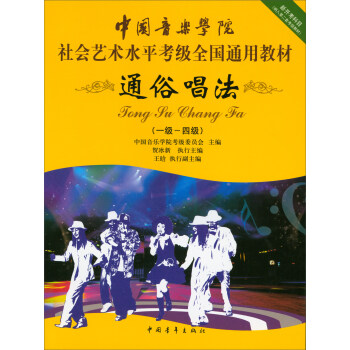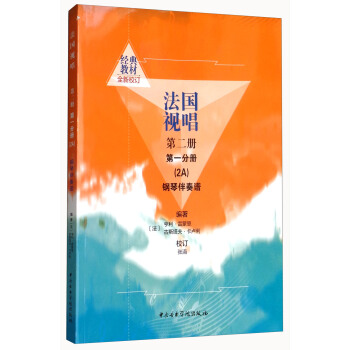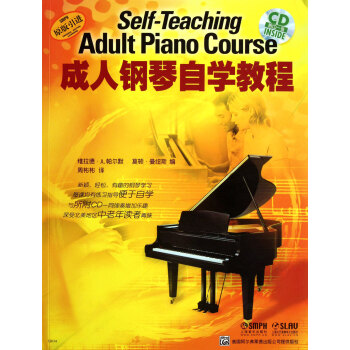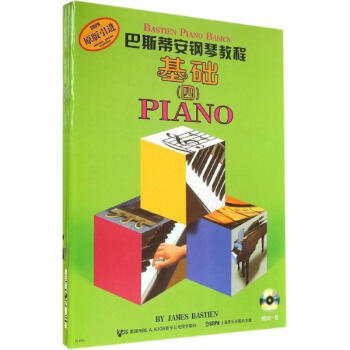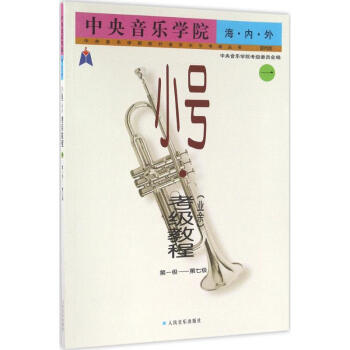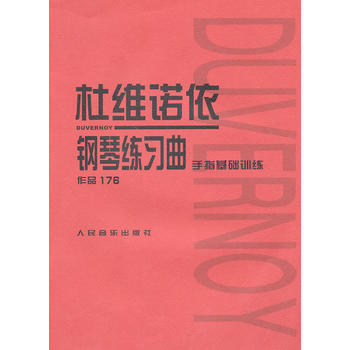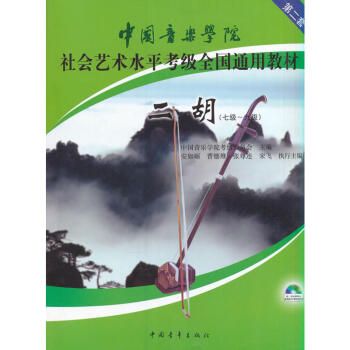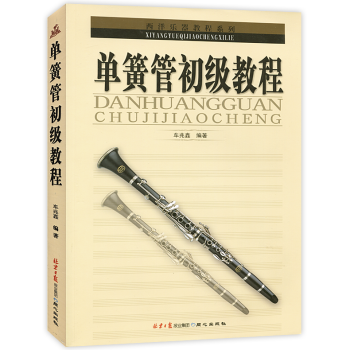![音乐学院英语教程 [College English for Music Majors]](https://pic.tinynews.org/12257994/5a0aae61N8315b7d7.jpg)

具体描述
内容简介
College English for Music Majors is initially designed for musicians and budding musicologists at the Central Conservatory of Music who are undertaking undergraduate studies, with Music as their Major. It is structured to be user friendly, inclusive and enjoyable: hopefully it may find a wider audience amongst the many, many undergraduates studying Music in China today.Over the years we have read thousands of articles about hundreds of composers. We have talked endlessly about the philosophy of education with learned musicologists. Mostly we have spent an inordinate amount of our waking time discussing how to integrate music, musical ability and musicology with English-learning and a love of the English language as it is written, spoken and sung. This volume is the result of a prolonged gestation indeed. We truly hope that it provides some scaffolding upon which to build a healthy knowledge of English, a language exquisitely rich in words, word-play, subtle meaning and plain speaking.
The text includes articles and exercises from a wide range of music experiences and genres as well as debates about music in education and the loss of music-related culture. It spans 500 years and more of European, Asian and American art, movie and avant-garde music. We have included articles about film music to represent the Seventh Art and musicology research papers to introduce students to the type of document they must needs read for their own research purposes, further down the line in time.
The exercises we have devised are partly designed to reinforce knowledge and usage of music terminology. Thus each unit comes with translation exercises and reading comprehension passages. Moreover, the questions are deliberately structured to broaden the students' vision and augment critical thinking. The level of language used is similar to the kind of English likely to be encountered when reading texts or learned documents. Note that the articles used have been edited and modified to suit the students' needs. There are glossaries available with each article, covering names, new words and music terminology.
It is important to note that in every case, the authors or publishers of the articles have been contacted in order to obtain permission to use them and to modify them to suit second-language users. Thus, alongside each article, one can find the acknowledgements. We wish at this juncture to thank most deeply the many authors who replied to our avalanche of letters, aided us in designing the edited versions and who went out of their way to encourage our small venture. At the same time, we extend a heart-felt thanks to the Director of CCOM and the editor of CCOM Press who guided us safety around many obstacles. The Musicology Department of CCOM and the librarians of CCOM and the National Library of China were ever helpful and knowledgeable and our colleagues at home and abroad were patient and generous, to a fault. All errors, we hope small ones only, remain ours.
内页插图
目录
Unit 1 Warming-upReading Focus
Why Study Music?
Extension
Music Education in Ancient Times
Cultural Perspective
Chinese People in Australia Today
Unit 2 Warming-up
Reading Focus
Family Ties
Extension
Versions, Interpretations and More
Cultural Perspective
String Quartet No. 13 and the Fate ofthe Composer
Unit 3 Warming-up
Reading Focus
Book Review
A History of Singing by John Porter and Neil Sorrell
Extension
Peter Grimes
Cultural Perspective
Britten's introduction to Peter Grimes
Unit 4 Warming-up
Reading Focus
What is Gamelan?
Extension
Collision of Cultures
Cultural Perspective
Colin McPhee
Unit 5 Warming-u p
Reading Focus
Arts Education in America
Extension
Music and Well-Being
Cultural Perspective
What is Language Loss?
Unit 6 Warming-up
Reading Focus
Music-making of Popular Musicians in the West
Extension
The Way Asian Popular Musicians Learn
Cultural Perspective
East Meets West
Unit 7 Warming-up
Reading Focus
On Being a Conductor
Extension
FXR
Cultural Perspective
Orchestras: A New Model for Effective Management
Unit 8 Warming-up
Reading Focus
Minimalist Music: Where to Start
Extensio n
The other Adams
Cultural Perspective
Modem Film Music: does Minimalism have a part to play?
Unit 9 Warming-u p
Reading Focus
The Arts in Education
Extension
Teaching the "Hard to Reach"
Cultural Perspective
Language acquisition and the advantages of being a musician
GIossary
Glossary of Music Terms
List of Personalities from the Texts
前言/序言
College English for Music Majors is initially designed for musicians and budding musicologists at the Central Conservatory of Music who are undertaking undergraduate studies, with Music as their Major. It is structured to be user friendly, inclusive and enjoyable: hopefully it may find a wider audience amongst the many, many undergraduates studying Music in China today.Over the years we have read thousands of articles about hundreds of composers. We have talked endlessly about the philosophy of education with learned musicologists. Mostly we have spent an inordinate amount of our waking time discussing how to integrate music, musical ability and musicology with English-learning and a love of the English language as it is written, spoken and sung. This volume is the result of a prolonged gestation indeed. We truly hope that it provides some scaffolding upon which to build a healthy knowledge of English, a language exquisitely rich in words, word-play, subtle meaning and plain speaking.
The text includes articles and exercises from a wide range of music experiences and genres as well as debates about music in education and the loss of music-related culture. It spans 500 years and more of European, Asian and American art, movie and avant-garde music. We have included articles about film music to represent the Seventh Art and musicology research papers to introduce students to the type of document they must needs read for their own research purposes, further down the line in time.
The exercises we have devised are partly designed to reinforce knowledge and usage of music terminology. Thus each unit comes with translation exercises and reading comprehension passages. Moreover, the questions are deliberately structured to broaden the students' vision and augment critical thinking. The level of language used is similar to the kind of English likely to be encountered when reading texts or learned documents. Note that the articles used have been edited and modified to suit the students' needs. There are glossaries available with each article, covering names, new words and music terminology.
It is important to note that in every case, the authors or publishers of the articles have been contacted in order to obtain permission to use them and to modify them to suit second-language users. Thus, alongside each article, one can find the acknowledgements. We wish at this juncture to thank most deeply the many authors who replied to our avalanche of letters, aided us in designing the edited versions and who went out of their way to encourage our small venture. At the same time, we extend a heart-felt thanks to the Director of CCOM and the editor of CCOM Press who guided us safety around many obstacles. The Musicology Department of CCOM and the librarians of CCOM and the National Library of China were ever helpful and knowledgeable and our colleagues at home and abroad were patient and generous, to a fault. All errors, we hope small ones only, remain ours.
用户评价
作为一名音乐专业的学生,我一直渴望能够更深入地理解那些来自世界各地的音乐文献和理论著作,但往往被晦涩的语言所阻挡。这本书的出现,彻底改变了我的困境。《音乐学院英语教程》的设计理念非常独到,它没有将英语学习与音乐知识割裂开来,而是将两者巧妙地融合在一起,形成了一种全新的学习模式。我尤其喜欢书中对不同音乐体裁的分析,例如,在讲解歌剧时,它不仅介绍了歌剧的历史发展和重要作曲家,还详细地解释了与歌剧相关的英语词汇,如 "aria," "libretto," "recitative",并辅以大量的听力材料和阅读篇章,让我能够在理解音乐的同时,提升我的英语听力和阅读能力。这种“沉浸式”的学习方式,让我感觉自己仿佛置身于一个真实的音乐交流环境,每一个单词、每一个句子都充满了音乐的韵味。更重要的是,这本书还关注到了音乐研究中常见的学术写作和论文撰写,这对于我将来撰写学术论文,发表研究成果至关重要。它提供了大量的范文和写作指导,让我能够模仿学习,逐步掌握学术英语的表达方式。我能感受到作者在编写这本书时,对音乐学科的深刻理解和对英语教学的精细打磨,这绝对是一本不可多得的精品教材。
评分拿到《音乐学院英语教程》这本书,我首先被它充满艺术气息的设计所吸引,封面上的音符和乐谱元素,让我对即将开始的学习充满了期待。翻阅内页,我发现这本书的编排逻辑清晰,内容循序渐进,非常适合我这样想要系统学习音乐英语的学生。它不像我之前看过的很多参考书,只是简单地罗列词汇和短语,而是将英语学习真正融入到音乐的语境中。例如,在介绍肖邦的作品时,它不仅提供了关于作品的背景信息,还穿插了与“romanticism,” “nocturne,” “polonaise” 等相关的英语词汇和表达,并且通过一些音乐片段的听力练习,加深了我对这些词汇的理解。我觉得最棒的是,这本书并没有忽略中国音乐的介绍,它在讲解世界音乐的同时,也融入了一些中国传统音乐的英语表达,这让我感到非常亲切,也为我将来用英语介绍中国音乐打下了基础。我特别喜欢书中的“文化角”栏目,它会介绍一些与音乐相关的跨文化交流的注意事项和礼仪,这对于我将来参与国际交流非常有帮助。整体而言,这本书的编写非常用心,充满了人文关怀,让我觉得学习英语的过程也是一次文化的探索之旅。
评分坦白说,我对英语学习一直存在畏难情绪,总觉得那些复杂的语法和大量的词汇是难以逾越的鸿沟。但是,《音乐学院英语教程》这本书,却神奇地将我的这种恐惧感转化为了一种学习的乐趣。它并没有采用传统教学中那种枯燥的填鸭式方法,而是将英语学习巧妙地融入到了我最热爱的音乐世界里。这本书最大的特色在于,它能够让我从音乐本身出发,去理解和学习英语。比如,在学习关于室内乐的部分时,书中不仅详细介绍了不同室内乐的体裁和历史,还顺理成章地引入了“quartet,” “sonata,” “ensemble” 等核心词汇,并且通过分析一些经典的室内乐作品的乐谱和音乐录音,让我深刻地理解了这些词汇在实际语境中的应用。更重要的是,这本书非常注重培养学生的实际应用能力,它提供了大量的听力、口语、阅读和写作练习,并且这些练习都紧密围绕着音乐主题展开,让我能够在反复练习中,逐步掌握用英语进行音乐交流的能力。我感觉自己就像在聆听一首优美的乐曲,在音乐的旋律中,我的英语也随之进步,这种学习体验是前所未有的,让我对自己的英语能力有了全新的认识和信心。
评分我之前接触过一些音乐英语的教材,但总觉得它们要么过于理论化,要么与实际应用脱节。《音乐学院英语教程》则完全不同,它最大的亮点在于其高度的实用性和前瞻性。我是一个对音乐产业和国际交流非常感兴趣的学生,而这本书正好满足了我的需求。它在课程设置上,充分考虑到了音乐专业学生在未来可能面临的各种场景,比如在国际音乐节上与同行交流、参加音乐相关的招聘面试、甚至是与外国音乐家进行合作。书中关于“音乐版权与法律”、“音乐市场营销”、“演出策划”等主题的内容,不仅讲解了相关的音乐知识,更重要的是,它教会了我如何用准确、专业的英语来表达这些概念。我特别欣赏书中提供的模拟对话和角色扮演练习,这让我在学习过程中,能够反复练习,不断提升我的口语表达能力和临场应变能力。而且,这本书的编排也非常人性化,每一课都包含词汇、语法、听力、口语、阅读和写作等多个环节,形成了一个完整的学习闭环,让我能够全面地提升我的英语水平。我已经迫不及待地想要将书中学到的知识运用到实际的学习和工作中,我相信它一定会成为我音乐道路上的一位得力助手。
评分这本《音乐学院英语教程》简直就像为我量身定做的!我一直对音乐充满热情,但英语学习总是让我觉得力不从心,特别是那些专业术语,简直让人头疼。这本书的出现,就像黑暗中的一道曙光。我翻开目录,首先就被它将音乐理论、音乐史、音乐家传记等内容巧妙地融入英语学习的方式所吸引。它不是那种枯燥乏味的语法和词汇堆砌,而是通过一个个生动有趣的音乐主题,让我不知不觉中掌握了新的词汇和表达方式。比如,书中关于巴洛克时期的介绍,不仅讲解了相关时期的音乐特点,还自然而然地引出了像"baroque," "ornamentation," "polyphony" 这样重要的音乐英语词汇,并且提供了详细的例句和练习,让我能够立刻理解并运用。最让我惊喜的是,它还涵盖了音乐欣赏、音乐评论等实用的交流场景,这对我来说简直是福音!我一直梦想着能用英语和国际上的音乐人交流,分享我对音乐的理解,这本书无疑为我打下了坚实的基础。它不仅仅是一本教材,更像是一位耐心细致的英语导师,时刻引导着我,让我觉得学习英语不再是一件痛苦的事情,而是一段充满探索和发现的旅程,让我对未来的音乐学习和交流充满信心。
相关图书
本站所有内容均为互联网搜索引擎提供的公开搜索信息,本站不存储任何数据与内容,任何内容与数据均与本站无关,如有需要请联系相关搜索引擎包括但不限于百度,google,bing,sogou 等
© 2025 book.idnshop.cc All Rights Reserved. 静思书屋 版权所有


